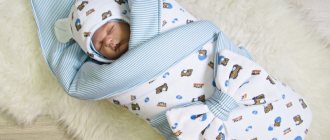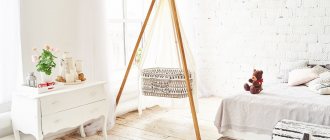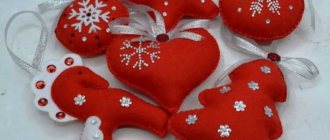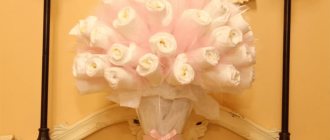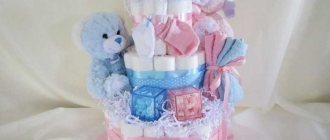Very often, for the birth of a child, you want to give some special gift, add a piece of your soul to it, invest love. 
Anti-scratch pads are the highlight that will not require much energy, will be useful to the baby and will be a pleasant addition to the gift!
I will consider doing it both using an overlocker and a sewing machine, since everyone’s equipment is different.
First of all, we are preparing a simple pattern for you.
Dimensions of the mitten itself:
- height - 6.5 cm;
- width - 6 cm.
We take allowances of 0.8-1 cm. The first value is for those who will sew on an overlocker, the second - for a machine.
Please note that I am building a mesh to construct. We make a rounding only on one side, so that later we can mirror it evenly. I do the rounding arbitrarily.
After this, we cut out our pattern and duplicate the rounding with scissors:
Next, I transfer the pattern onto paper again and mark the allowances. As practice shows, a pattern with seam allowances is very easy to use. But you can mark them directly on the fabric.
Now let's do the cuffs. we need to calculate the elongation coefficient. Take a piece of fabric 10 cm long.
After that, stretch it against the ruler and see what length it turns out. You need to pull not to the limit, but to a comfortable fit.
In my case, a piece of ribana stretched to 13 cm.
We get the coefficient:
10/13 = 0,77
Now let's calculate the length of our cuff.
Mitten length 6 (front half) + 6 (back half) = 12 cm.
12*0.77=9.24 cm. This means the length of the cuff will be 9-9.5 cm.
I take the width to be 5 cm (in finished form it is 2.5 cm, since we will bend it in half).
Allowances are similar to the mitten:
Let's start cutting.
By the way, to determine the front side of the ribana, you just need to pull its edge. Which way is it wrapped - this side and the front side:
Now let's cut:
For the mittens, be sure to make marks along the central axis, this will make it easier to combine them 
Now we chop off the mittens in pairs with needles, you can even sweep them by hand. And we assemble the cuffs with needles:
Let's proceed to the first assembly option - using an overlocker.
If you don't have one, just skip to the machine part. 
What are scratches for?
Very often, children are born with long fingernails, which cannot always be cut in time. And when cutting them, it is advised not to leave them too short. Because of this, babies scratch themselves, because all their movements are absolutely chaotic. It is precisely this problem that special mittens for newborns will eliminate. Some people think that they are harmful because they do not allow the skin of the hands to breathe and do not allow the baby to tactilely explore the world around him. The accessory also prevents him from holding a rattle or bottle. However, it should be remembered that scratches are dangerous for the skin of a newborn: due to weak immunity, an infection can develop.
How are scratch mittens different from regular mittens? Because they don't have a thumb compartment. As a result, the finished product looks like a bag, which is held in place by an elastic band or a beautiful ribbon. If you wish, you can sew or knit it in the form of a regular mitten, but then you will have problems putting it on.
How to properly dress a newborn?
A newly born baby should be dressed exclusively in natural materials, which include mainly “breathable” cotton and flannel fabrics, as well as lightweight knitwear.
Synthetics are strictly contraindicated: in the summer the baby sweats, and in the winter he freezes!
At home, one or two vests, rompers or light overalls are enough. If your baby's arms and legs are cold, he should wear sleeves and socks.
As for a hat, cap or scarf on a newborn’s head, there is no clear answer to this question either among “experienced” mothers and grandmothers, or experienced pediatricians.
There are two completely opposite opinions: some assert with complete confidence that a cap at home is mandatory even in hot weather, others believe that a cap should be worn depending on the situation - when going out onto the balcony or, in extreme cases, after taking a bath, and then only for 20-30 minutes, until your head dries out.
Types of caps for newborns
Hats for babies should be soft, light colors, made of natural fabrics, preferably cotton. In such hats, children do not get hot or cold, they do not sweat, and the delicate skin of the back of the head does not become irritated or subject to diaper rash.
Modern stores offer a huge variety of caps for newborns, differing in color, shape and design.
Smart cap
When choosing hats for babies, you need to take into account the following features:
- the cap should be soft, hygroscopic, allow air to pass through well, not tightly fit the baby’s head and at the same time not bunch up;
- when purchasing caps, you should focus not so much on the age parameters indicated by the manufacturer on the label, but on the size of the head of the newborn itself;
- It is advisable to avoid bright hats, with various pictures or ornaments, since fabrics with pictures can cause allergies in the baby.
The best choice is a plain cotton cap with wide and soft ribbons.
Until what age should it be used?
Each child is different, so it is difficult to say how long you will need to use scratches. For newborns, they may not be needed at all, and some children will have to wear them until almost six months. Most often, they wave their arms sharply during the first 3 months, but it all depends on the mother’s opinion. Experts advise using them as little as possible - after all, the baby must develop and get used to his hands. Babies start reaching for toys at about two months, so it's worth letting them touch and examine everything.
If it becomes noticeable that the child is showing interest in surrounding objects, then it is better to remove the mittens from him. It happens that inexperienced mothers do not know how to do the right thing. Then they should adhere to a period of three months. However, the accessory can only be worn at night.
Is the baby cold or hot?
An inexperienced mother should know the basic rules for determining temperature for a small family member:
You should never rely on a thermometer that shows the temperature of a room or street, and even more so, on your own sensations and well-being. What needs to be taken into account is not the condition of the baby’s fingertips or nose, but the area of the feet, upper back, folds of the neck and crown. The main indicator is humidity (the child is hot and sweating) or, conversely, the coolness of certain parts of the body (the baby is cold). If in the first case it is necessary to change the baby into lighter clothes, then in the second, of course, you need to dress the baby warmer.. The best room temperature for a baby is 25-27 degrees Celsius.
The best room temperature for a baby is 25-27 degrees Celsius.
Selection of material and tools
These special mittens can be purchased and can also be sewn, knitted or crocheted. For newborns, in this case, you will need natural materials. For sewing, it is best to use flannel, kulir, knitwear or any other fabric that is pleasant to the touch. It should not cause irritation (possible heat rash), so it is better to choose a material that is not too thick. For two scratches you will need: two pieces of fabric measuring 180x130 mm, a regular elastic band 140 mm long, a needle, thread.
To crochet them, you need to choose a yarn. In this case, it is better to choose thin cotton, for example, VITA Pelican. For work you will need: yarn (you can take leftovers), hook No. 2 and a beautiful ribbon measuring 5x600 mm.
The mitten can also be knitted from natural yarn, although acrylic is also suitable (for example, Jiffy Yarn Fisherman). An acrylic product will keep your hands warmer if it’s cool at home. The work is done on five double needles No. 2-4, i.e. you need to knit in the round. You can cut a piece of ribbon or knit a cord from yarn.
Negative consequences
If parents do not know how to wear a collar for a newborn and self-medicate, complications may arise for the child. These include the following conditions:
- if the collar is over-tensioned, it begins to compress the neck and trachea area, leading to breathing problems. As a result, the child begins to experience hypoxia and the functioning of the cardiovascular system changes;
- With prolonged use of the splint, hypotrophy or atrophy of the neck muscles occurs. In the absence of load, their volume decreases, which can lead to the progression of the underlying disease. At the age of two months, children can hold their heads well and the collar should only be used for a short time.
The use of homemade devices is prohibited. Tires must be manufactured in accordance with existing standards and from materials approved for use for newborns.
The Shants collar for newborns is an important part of the treatment of congenital neck pathologies. It allows you to fix it in a physiological position and prevent the further development of diseases
In therapy using a splint, it is important to choose the right one in consultation with an orthopedist. The doctor will choose the size of the collar, explain how to put it on, and describe a wearing pattern during the first weeks of treatment
If the child is constantly restless or there are external signs of soft tissue compression by the splint, parents should immediately consult a doctor.
Sew scratches
Before you start sewing, you need to prepare a pattern. To do this, take tracing paper (a sheet of paper) and draw a rectangle measuring 90x130 mm. We round the upper edges of the future mitten and cut out the blank. Let's prepare the elastic band right away: take the desired length and cut it in half. You should decide on the location of the seams, which can be internal, external or hidden (between layers of fabric).
We take the finished pattern, place it on the fabric and trace it. We cut out the parts, lean them against each other and sew them together, leaving a hole for the handles. We apply the elastic to the bottom edge of the product, turn it in 2 cm and stitch it. We decorate ready-made scratches for newborns with ribbons, bows, embroidery or lace. If desired, you can increase the length of the cuff - then the elastic will no longer be needed.
Arguments for the cap
It is believed that the body of a newly born baby is still disproportionate, and the head is larger than the rest of the body.
For this reason, a newborn needs a light hat at any time of the year to protect him from possible drafts, temperature changes between rooms within the same apartment, and also to cover the baby’s still fragile fontanel.
Hats for a newborn should be light in the summer and moderately warm in the autumn-winter months and in no case contain buttons, snaps, tight laces and other various accessories, as well as hard and rough seams.
Mothers who advocate wearing a hat at home at any time of the day should be very careful, since the cap, as a result of involuntary movements of the head, can fall to the side or cover the baby’s face, which will lead to a lack of oxygen and difficulty breathing.
Crochet
We crochet 4 loops, connect them into a ring and start knitting in the round. If possible, you can try on the mittens on your baby or use the sizes indicated above. They are knitted in single crochet stitches, and at the end the rows end with a connecting loop.
We work with rows like this:
- First: 2 lifting loops and 7 columns.
- Second: 2 lifting loops, 2 columns in each column of the previous row.
- Third: 2 lifting loops, alternately knitting 2 stitches into one, 1 stitch, etc.
- Fourth: 2 lifting loops, alternately knitting 2 stitches into one, 2 stitches, etc.
We continue to add loops until the width of the product reaches 80-90 mm. We continue working without adding (about 7-10 rows). To move to the cuff, we make decreases: we reduce each row by 2 loops. Next, we knit the cuff either with an elastic band (knitting needles) or double crochets (crochet). For newborns, beautiful lace around the edge of the product is suitable. Finish the work and cut the thread. We repeat all the steps for the second scratch and decorate both with ribbons or laces.
Is it useful or not?
Determining at what age a child needs this product is not easy. Some people stop scratching themselves after just a few days, while others continue to use their nails for another three months.
Each case is individual. You yourself must understand when to remove scratches. But we recommend not to delay wearing them. Newborns begin to explore the world around them by touching different objects. They pick up toys and various things that lie nearby, which is almost impossible to do with such “gloves.”
Another disadvantage of wearing the product for a long time is that the baby’s hands will sweat, and this can negatively affect health.
If you are afraid that your baby will not be able to explore the world through touch, we recommend that you stop wearing scratchers after three months.
If your child still scratches himself, then wear the products only at night, and keep an eye on him during the day.
On Vikids you can:
Knitting with knitting needles
A knitted mitten will only work if the number of stitches is calculated correctly. For example, if there are 3 loops in 1 cm, then using needles No. 2 you need to cast on 40 loops (we move from the wrist to the fingertips). We distribute them onto stocking needles: 10 pcs. on a knitting needle. We begin to knit a 1×1 elastic band (in the round) with a height of 50 mm. As soon as the elastic is ready, we knit a row with holes for the ribbon or lace. It is knitted as follows: knit 2 together, yarn over, etc. In the next row, yarn overs should make knit stitches, knitted behind the back wall.
Next we knit using stockinette stitch or any pattern you like (you can even choose an original pattern). The height of the main fabric is 80 mm (with elastic 130 mm). After this there will be decreases: in each row at the end of each knitting needle we knit 2 loops together. We stop when there are 8 loops left and tighten them. We fasten the end of the thread and hide it. We thread a ribbon or lace made of air loops into the scratches for newborns.
The resulting mittens will not only protect the child’s health, but will also become a beautiful addition to any set of clothes. After all, you can experiment not only with the ornament of the product, but also with its color palette.
Arguments against the bonnet
Firstly, only a born person has practically the same rights as other family members. If a healthy adult would never think of wearing a hat at home, then for what reason does a newborn need to cover his head?
Knitted cap
Secondly, the less you wrap a child, the healthier he will grow. Inside the rooms, the air temperature is never changeable, and the cap, in turn, fitting tightly to the head, creates a kind of greenhouse effect, causing only harm to the newborn baby and preventing the baby’s delicate skin from breathing.
Whatever the parents’ decision on the issue of whether to put on a newborn cap (cap, scarf), you should always remember the advice of the famous pediatrician Komarovsky that the baby’s skin should breathe.
Advantages and disadvantages of putting a cap on a newborn at home
- a sweat patch appears on the lower part of the back of the head;
- excessive wrapping leads to a natural result - frequent colds, you just need to blow a little breeze;
- the complete lack of hardening of the child is a counterbalance to a healthy lifestyle.
A newborn's constantly exposed head can cause:
- diseases of the middle ear or the development of meningitis;
- bending of one of the ears, since the baby may involuntarily lie on the ear during sleep.
What happens in practice?
Most young mothers start from a specific situation and adapt to the circumstances: they put on a cap after bathing, ventilating the children's room, when the heating is turned off, and also if the room temperature drops below 20 degrees Celsius, etc.
There are no compromises in the issue of putting caps on the head of a newborn: the older generation - grandmothers and mothers-in-law - are ardent supporters of wearing a cap at home up to one year old, modern pediatricians and new mothers believe that overheating is much dangerous for the baby’s health.
The newborn should have the same number of layers of clothing as the mother + one more.
Floor-standing
Perhaps the simplest designs to implement. They can be of various shapes and located on the floor or at an angle to it. In addition, they can be combined with some other elements, columns, houses.
How to make a floor scratching post
We suggest making a floor scratching post from corrugated cardboard yourself with step-by-step instructions. To work you will need:
- construction tape,
- pencil,
- ruler,
- scissors or wallpaper knife,
- glue.
You can take a box with low sides for the mold, but you can do without it by securing the finished structure with cardboard tape around the perimeter.
Necessary tools for making a scratching post
Place the strips tightly in the box
Cut the cardboard into strips to fit the length and height of the box. Glue the strips with glue and connect them. It is advisable to use glue with a minimally noticeable odor, for example, PVA. After drying, the nail clipper is ready for use.
Simple round corrugated cardboard scratching post
Corrugated cardboard bends quite easily, so the second version of the scratching post is a twisted long strip secured with glue or adhesive tape. In this case, the size can be chosen at your discretion, and in case of long-term use, simply add layers as the shaggy consumer grows.
Regular wearing
The doctor determines how long the Shants collar is worn
It is important for parents to know how long the Shants collar is worn. If the pathology is congenital, then the orthopedic product is used during the first month of the child’s life
It is important to understand that the amount of time with a splint during the day can vary significantly - from 10 minutes to round-the-clock use. This depends on the nature of the pathology and its severity.
After a month, parents re-visit the orthopedist, neurologist and other specialists, depending on the disease. They evaluate the newborn's condition and, if necessary, advise continued use of the Shants collar.
Crocheted baby scratchies for newborns. Master class with step-by-step photos
In this master class you will learn how to crochet baby scratches . For the mother of a newborn baby, it would be a big problem to put mittens on his tiny hands. Here we are not even talking about gloves, which, you see, is practically impossible, but even about ordinary mittens with a big “finger”.
But savvy mothers have long come up with a tiny part of the wardrobe for their babies - scratchies, which can be easily put on even the most restless baby.
To crochet scratches you will need:
- blue and white denim yarn,
- sand-colored "iris" yarn,
- 4 buttons with holes as car wheels,
- threads with a needle,
- scissors.
Base options
Item needed:
- strong enough to support the weight of the animal;
- lightweight so that bulky structures are not required for mounting to the wall;
- Receptive to glue well, good for processing with tools.
Cheapness is an important parameter, but not as much as for coating. The base is expected to last a long time. Is this always necessary? Assess the complexity and wear time of the craft. It may turn out that it is more rational to replace it completely than to remove the glue.
For the base take:
Note!
How to make wooden shelves with your own hands - original design options
Kinusaiga technique for beginners: what is it, a description of creating paintings from threads
How to weave a figurine from rubber bands: how to learn to weave animals, toys and what you can make from rubber bands on a slingshot
- plastic water and sewer pipes - they are easily sawed across and lengthwise, it is easy to make a frame of any shape from them with reliable fastenings from standard adapters;
- pieces of plywood of various thicknesses;
- sections of tree branches after sanitary pruning at the dacha (necessarily healthy fragments, so as not to bring pests into the house).
The branches can also be used for decoration: a cat lying on them, attached to the ceiling, will decorate any apartment.
Corner
Can be installed on both external and internal corners. Corner scratching posts, like wall-mounted ones, unlike floor-mounted ones, require durable fasteners. The distance from the floor should be chosen based on the size of the pet, and installed in the places most favorite for scratching.
Corner scratching post with platform Corner scratching post
Simple corner scratching post
You can also install the corner structure on furniture. An aesthetically executed scratch will not greatly spoil the appearance of a sofa or chair, but it will protect against the claws of an animal if it gets into the habit of sharpening its claws in this particular place.
A corner scratching post on the sofa will protect the upholstery from claws
How to make a beautiful corner scratching post
Pros of homemade clothing
Before deciding to make their own clothes, many mothers weigh the pros and cons. Creating clothes for babies is not only interesting and simple, but also useful. The advantages of such products are the following factors:
- By choosing the simplest patterns, even a beginner will be able to cope with the work, creating unique items in a single copy. It turns out that the thing is completely designer.
- Only high-quality materials will be used for production.
- You can choose any color scheme and create a unique finish.
- The sizes may be non-standard, since the pattern is made independently.
- In addition to clothes, you can make other items for the baby, which can also additionally decorate the house.
- Thanks to original combinations and experiments, you can create truly universal things.
- This skill can become the basis of a business for a mother on maternity leave, since every item will be non-standard.
Sewing items for newborns yourself is not difficult if you do everything correctly and carefully.
Every year fashion brings new versions of models not only for an adult wardrobe, but also for children. You can bring a lot of things to life yourself - sew things yourself, and not only things. For everything to work out, you need to correctly remove the marks from the newborn and prepare a pattern. The work itself will not take much time, but it will definitely bring a lot of pleasure. Moreover, when designing things, you can show your imagination and choose the materials you like.
Types of scratching posts
Felinologists, experts in the anatomy and physiology of domestic cats, recommend acquiring at least three different types of cat cats and placing them where the animal most often stops to sharpen its claws.
The simplest and most affordable types of claws:
- corner;
- wall;
- pillars;
- floor;
- complex.
They are easy to make with your own hands, spending a minimum of time and money. This can be a board, a sheet of chipboard or plywood, wrapped in thick fabric, burlap, a piece of old carpet or coarse twine purchased at a hardware store. If there is a container made of corrugated cardboard (corrugated cardboard) left in the house, then it can also be used.
Wall-mounted nail clipper with fastenings
Wall hanging nail clipper
There is another type of device where cats can sharpen their claws - this is a complex. You can build it for one pet or for several. It requires more space and is more difficult to manufacture.
Before you start making a scratching post with your own hands, it is advisable to observe what your pet likes best. One likes to climb almost to the ceiling and look around his possessions from there. Another is comfortable in a cozy house with a small opening to the outside. The third, like a true athlete, is ready to overcome obstacles for days on end, jump and jump over everything that catches his eye. With a little ingenuity, you can captivate your pet so much that he will not see anything around him except the play complex.
Sharpening claws is a natural need for a cat
Not vitally important, like eating, sleeping or going to the litter box, but scratch marks will cause the animal to lose a significant amount of comfort. Owners have to regularly change chairs, upholstery on upholstered furniture, and throw out boxes. Purchasing a cat scratcher will help in part. How to choose her so that she will be successful with the beast?
- choose a covering: from corrugated cardboard to sisal, as long as the animal likes it;
- find a comfortable place - one where your pet likes to sharpen its claws, but don’t forget about yourself, everyone makes this choice together;
- think about the shape, color and fastening.
You may be able to find one that is approximately suitable at a pet store. But purchased products are disposable and will soon deteriorate with intensive use. It’s possible to make a repairable cat house with your own hands.
